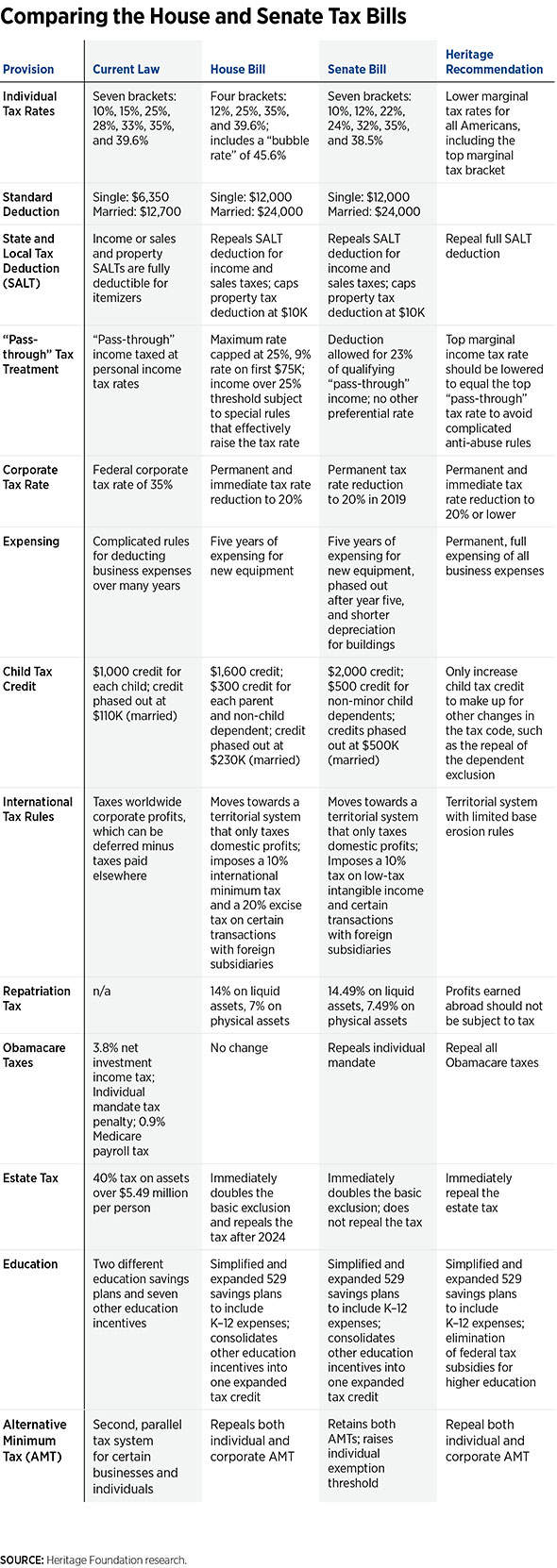 On December 2, 2017 we posted Senate Passes $1.4 Trillion Tax Cut Legislation where we discussed that the U.S. Senate passed an expansive tax cut bill early Saturday that is projected to add more than $1 trillion to the deficit, after garnering enough support from faltering and fiscally conservative Republicans.
On December 2, 2017 we posted Senate Passes $1.4 Trillion Tax Cut Legislation where we discussed that the U.S. Senate passed an expansive tax cut bill early Saturday that is projected to add more than $1 trillion to the deficit, after garnering enough support from faltering and fiscally conservative Republicans.
Now the Senate and the House have each passed their own version of the “Tax Cuts and Jobs Act.” The two versions of the bill have many similar provisions, but they also have a number of key differences that will have to be reconciled by the Conference Committee as the two bills are merged into a single piece of legislation.
It is unclear at this point how these differences will be resolved. However, there is generally an inclination that the Senate's provisions carry somewhat more weight because, since the Senate is subject to budgetary restraints as part of the reconciliation process, there is less flexibility to make changes to their bill.
The following are among the more significant differences between the two versions of the bill.

Sunset provision. The Senate bill, in order to comply with certain budgetary constraints, provided an expiration date of Jan. 1, 2026 for many of the tax breaks in its bill, especially those for individuals. The House, on the other hand, largely made the changes in its bill permanent.
Individual rates and brackets. The Senate bill has seven tax brackets for individuals with rates ranging from 10% to 38.5%. The House bill has four tax brackets ranging from 12% to 39.6%, retaining the top rate under current law.
Individual alternative minimum tax (AMT). The House bill would repeal AMT for individuals. The Senate bill would retain the individual AMT, with increases to the exemption amounts.
Estate tax. Both bills would significantly increase the estate and gift tax exemption, but the House would also repeal the estate tax after Dec. 31, 2024.
Individual mandate. The Senate bill would effectively repeal the individual mandate (i.e., by reducing the penalty amount to zero). The House version has no such provision.
Mortgage interest deduction. The Senate bill would leave the deduction for interest on acquisition indebtedness intact but would suspend the deduction for interest on home equity indebtedness. The House bill would allow the deduction for interest on acquisition indebtedness, but would, for newly purchased homes, reduce the current $1 million limitation to $500,000 ($250,000 for married individuals filing separately), and would allow the deduction only for interest on a taxpayer's principal residence. Interest on home equity indebtedness incurred after the effective date of the House bill would not be deductible.
Medical expense deduction. The House bill would repeal deductions for medical expenses under Code Sec. 213 outright, but the Senate bill would take a step in the opposite direction and temporarily (and retroactively) reduce the floor from 10% under current law to 7.5% for all taxpayers for tax years beginning after Dec. 31, 2016 and ending before Jan. 1, 2019, after which time the 10% floor would be scheduled to return.
Child tax credit. The Senate bill would increase the child tax credit from $1,000 under current law to $2,000, increase the age limit for a qualifying child by one year (for tax years beginning after Dec. 31, 2017 and before Jan. 1, 2025), increase the income level at which the credit phases out ($75,000 for single filers and $110,000 for joint filers under current law) to $500,000, and reduce the earned income threshold for the refundable portion of the credit from $3,000 to $2,500. The House bill would increase the amount of the credit to $1,600 and increase the income levels at which the credit phases out to $115,000 for single filers and $230,000 for joint filers.
Both bills would also provide a non-child dependent credit, which would be $500 under the Senate bill and $300 under the House bill. The House bill would also provide a “family flexibility credit”; the Senate bill has no equivalent.
Business Provisions
Effective date of corporate tax reduction. Both bills would reduce the corporate tax rate to 20%, but the House's version would go into effect for tax years beginning after Dec. 31, 2017, whereas the Senate's version would go into effect for tax years beginning after Dec. 31, 2018.
Corporate AMT. The House bill would repeal the corporate AMT. The Senate bill, however, would retain the corporate AMT at its current 20% rate.
Section 179 expensing. Both bills would increase the expensing cap and phase-out under Code Sec. 179, but the Senate would increase the cap to $1 million and begin the phase-out at $2.5 million (up from $520,000 and $2,070,000 for 2018 under current law), whereas the House would increase the cap to $5 million and start the phase-out at $20 million.
Pass-through provision. The Senate bill would generally allow a non-corporate taxpayer who has qualified business income (QBI) from a partnership, S corporation, or sole proprietorship to claim a deduction equal to 23% of pass-through income. The House bill would provide a new maximum rate of 25% on the “business income” of individuals, with a series of complex anti-abuse rules to prevent the re-characterization of wages as business income.
Need Tax Help?
Sources:
Read more at: Tax Times blog






